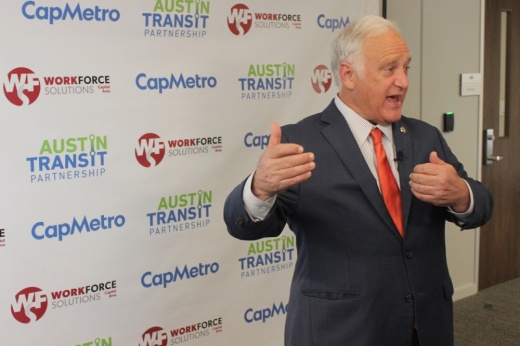During an Oct. 12-13 summit hosted by Workforce Solutions Capital Area in Austin, officials promoted the first-ever mobility workforce study conducted for the region and shared their thoughts on how Central Texas employers and residents can take advantage of what's to come.
"It’s just this perfect storm of opportunities, but it also tells us that if we don’t plan for the workforce of the future we will be caught behind," said Tamara Atkinson, Workforce Solutions Capital Area's president and CEO.
The overview
Area government and economic leaders said they're paying close attention to local workforce trends as generational infrastructure investments pour in. In Austin alone, billions of dollars will be spent expanding the airport, widening I-35 through the city center and building out the Project Connect light rail system—all of which are projected to create 10,000 additional mobility and infrastructure jobs.
Beyond city limits though, leaders are also keeping an eye on what the broader connections between Austin and San Antonio can mean for their futures.
Austin Mayor Kirk Watson and San Antonio Mayor Ron Nirenberg announced a new civic partnership during the October summit. Watson noted, while there's been a longtime recognition of the ties shared by both cities, leaders are now moving for more strategic collaboration.
"[The goal is] to now try to systematically work together in such a way so that 20 years from now, that work means that this region, a sum of the component parts of the region, the cities in that region up and down that corridor all are better off, and the region as a whole is better off," he said. "Where we’re announcing the first effort to really do that collaboration will be in the area of workforce development.”
The new workforce analysis prepared by Austin-based urban strategy firm CivicSol also included insights into the makeup of the regional workforce, findings Nirenberg said will inform how local governments take action.
“The majority of San Antonio’s Ready to Work program participants are women of color living at or below the poverty line, highlighting the fact that there isn’t one issue or challenge that wouldn’t benefit from more women being engaged with it,” he said in a statement. “We need to be intentional in our efforts to shift long-standing gender norms, and spotlight the mobility and infrastructure career opportunities that are available to women from Austin to San Antonio.”
What's next
Watson said the initial findings and a general action plan from the workforce study will help inform next steps for regional players across recruitment, coordination and funding opportunities.
Atkinson said a working group of more than 140 community partners will now review the initial analysis to create a more detailed action plan this fall.
“We know that there will be new training programs, better navigation, better funding and better transparency so that people know what the opportunities are and how to take advantage of them," she said.
Also of note
Another major infrastructure investment for the Austin-San Antonio corridor could come from the rail network linking the cities.
Through funding dedicated in the federal Bipartisan Infrastructure Law, Watson said the area may be now poised to take advantage of potential Amtrak service expansions.
“The way that they’re starting is they’re looking where the people are, and they’re looking where the growth is. ... Texas is growing, and growing rapidly by comparison relative to the rest of the country. But the triangle of Dallas-Fort Worth to Houston, over to San Antonio, and then back up to Dallas-Fort Worth right through Austin, Texas, is a key part of that," he said. "The Austin-San Antonio corridor is well-positioned to be the first place for that to start.”
That effort could build on work already going on in that Texas "triangle." Earlier this summer, the national rail company announced it was exploring a partnership on a long-proposed high-speed rail route between Dallas to Houston backed by Japan-based Texas Central.





